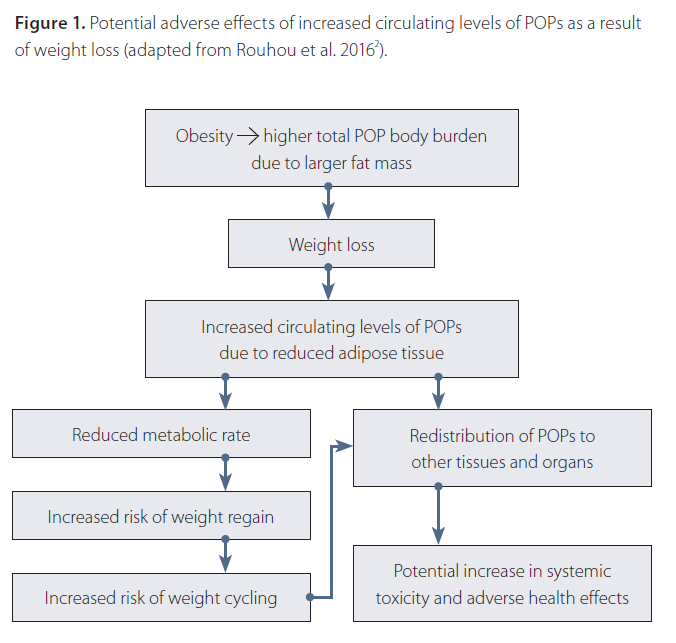Introduction
Humans are constantly exposed to synthetic environmental chemicals found in household items, industrial products, pesticides, herbicides, plastics, flame retardants, paints, electrical equipment, cosmetics, and food preservatives. Many of these compounds are endocrine-disrupting chemicals (EDCs) that interfere with the endocrine system, including adipose tissue. EDCs may alter physiology during the whole life span of an individual, from fetal development to adulthood.1 Persistent organic pollutants (POPs) such as polychlorinated biphenyls (PCBs) and bisphenol A (BPA) are the most well-known classes of chemicals that affect multiple endocrine mechanisms. POPs are particularly known to accumulate in the adipose tissue due to their fat-soluble property.2
For individuals with obesity, weight loss is important in reducing cardiometabolic risk factors. However, during weight loss, POPs that have been stored in the adipose tissue are released into the bloodstream due to loss of adipose tissue. POPs may potentially offset the benefits of weight loss and may even promote weight regain.2
| Download the PDF |
Research Highlights
- Humans are constantly exposed to synthetic environmental chemicals, many of which have obesogenic properties and may disrupt the endocrine system and metabolism1
- Rapid weight loss could lead to the release of POP from adipose tissue and increase serum POPs concentrations because of reduced body fat2-5
- The released POPs during weight loss are redistributed to other tissues including brain, liver, and kidney and may lead to adverse health effects1,2,6
- In weight-loss programs, the increased circulating POPs should be addressed to minimize their potentially harmful effects including weight regain
Mechanisms of action
Many EDCs have been demonstrated to promote obesity. The obesogenic mechanisms of these chemicals include:6
- Increase the number and/or size of adipocytes (fat cells), resulting in a larger fat tissue mass. Such an increase allows additional storage of EDCs, further compounding EDC-mediated adverse effects
- Disrupt adipocyte function leading to increased lipid production
- Alter appetite, satiety, and food preferences by disrupting hormone profiles
EDCs may also contribute to metabolic dysfunction and promote obesity-related complications (such as insulin resistance, glucose intolerance, hepatic steatosis, and/or metabolic syndrome) by affecting multiple endocrine mechanisms:1
- Modulating energy intake: altering hypothalamic neuropeptides that control food intake, intestinal nutrient transporters, secretion of gut peptides, as well as the gut microbiota composition
- Affecting energy output: acting directly on the thyroid hormone production and action, skeletal muscle, and brown adipose tissue
- Disturbing insulin release from β cells, which affects lipogenesis and alters insulin-dependent glucose metabolism in skeletal muscle, white adipose tissue, and the liver
Evidence of increased chemical exposure during weight loss
- Total POP body burden is 2-3 times higher in those with obesity than in subjects with normal BMI. After weight loss, the increased serum levels of POPs are positively correlated with liver toxicity markers, independently of age and BMI.3
- It has been demonstrated that increases in plasma POPs are proportional to the magnitude of weight loss. In 8 bariatric surgery patients who lost the most body weight (an average 46%) 1 year after surgery, plasma POPs levels were increased by 388%.4
- In a review of 5 weight loss studies involving 207 participants, blood concentrations of POPs were increased by 2-4% per kg weight loss 1 year following weight reduction.5

Potential approaches that support eliminations
of chemicals
Increased levels of chemicals during weight loss, particularly POPs, should be addressed in order to minimize their harmful effects (Figure 1). Unfortunately, not only are POPs difficult to metabolize, their reabsorption of through enterohepatic circulation also increases their half-lives. Although more clinical studies are greatly needed, certain plant-based ingredients and behavioral approaches that have been proposed to facilitate the excretion of POPs warrant consideration.
- POPs are mainly excreted in feces through bile. Phytochemicals such as silymarin (from milk thistle) and diosgenin (from wild yam) have been shown to increase bile synthesis and secretion in experimental models of hepatocellular cholestasis in rats.7,8
- Dietary fibers, particularly those with high lignin contents (such as rice bran fiber), have been shown to bind to POPs in in vitro models and
absorb POPs in the bile in mice, thereby increasing the excretion of POPs in feces.9,10 - Green tea consumption has been shown to lower the plasma levels
and enhance fecal excretion of lipid-soluble compounds, including
POPs, in rats.11,12 - Bile stasis delays the excretion of POPs. Experimental models in mice and rats have demonstrated that time-restricted feeding with intermittent fasting or physical activity increases bile flow and increases clearance of chemicals.13,14
- An intervention involving vitamin/mineral supplementation, polyunsaturated oils, sauna, and exercise for 3 weeks has been shown to reduce the body burden of PCBs and hexachlorobenzene by 16% and 30%, respectively, in electrical workers.15
- In patients with metabolic syndrome, a 3-week dietary detoxification program reduced serum γ-glutamyltransferase (a surrogate marker for overall toxic burden) and improved metabolic biomarkers.16


